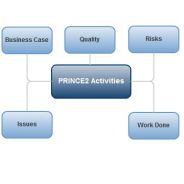Stakeholders in Project Management: The Basic Guide

The terminology of “stakeholder” and “stakeholder management” within the project management domain has become increasingly accepted in business in the last three decades, particularly with regard to operational and leadership performance.
First defined by American professor Edward Freeman in 1984, this strategic approach helps project managers identify and engage with individuals or groups—otherwise “stakeholders”—to balance their competing interests and integrate their needs and expectations into project planning and execution.
This guide introduces you to the basics of project stakeholders and how to manage them, covering everything from definitions and roles to approaches, challenges, and solutions.
This guide is written primarily for:
- Team leaders moving into a new management position who, for the first time, have to deal with project stakeholders rather than simply manage teamwork and internal collaborative activities.
- Project managers who are seeking to improve their own performance and their approach to stakeholder management.
- C-suite and directors looking for additional tools and techniques to engage with project stakeholders facing operational and leadership challenges.
For convenience, I break down this guide into three sections:
- Understanding project stakeholder
- Managing project stakeholders
- Common issues and solutions
1. Understanding Project Stakeholders
In a nutshell, a project stakeholder is any individual, business or group that is affected by the work of the project, either directly or indirectly.
As more and more organizations get involved in specialized projects that require closer organizational and team coordination, understanding how best to work with project stakeholders becomes a vital and key competence for project managers and team leaders.
What Is a Stakeholder in Project Management?
In project management, stakeholders can be defined as an individual, group or organization that:
Affects or is affected by the project.
- Has a stake, a claim, or an interest in the project implementation and decisions regarding legal, technical, operational, labor, or financial claims.
- Supplies monetary, human, technology, and other resources that are critical to project success.
- Affects project performance, either favorably or unfavorably.
Project stakeholders directly engage with each other during the course of a project, having detailed information and opinions on a specific issue or decision. Some can participate in the project as independent consultants, contractors, and part-time workers who interact with others sporadically, depending on their contribution to the project.
Below are some of the basic principles of the project stakeholder role:
- Participate in making decisions about actions that affect the project in some way.
- Promote only sustainable decisions by recognizing and communicating the needs and interests of all project participants.
- Facilitate the engagement of those potentially affected by or interested in a decision.
- Provide their subject matter expertise and communicate their feedback to other project participants.
Stakeholders can be identified as business customers, government organizations, scientific, education, and R&D organizations, technology providers, technical staff, investors, and more.
The list of stakeholders is always subject to change based on their different interests. Information about potential stakeholders is typically obtained through questionnaires, interviews, or focus groups. They can also be identified by their demographics or primary interests.
Project Stakeholder: Roles and Examples
There are a few typical roles that are performed by stakeholders at various times throughout the project lifecycle.
Usually, the project plan defines the roles and responsibilities of the people and organizations that are affected by the project in any way. It is important to understand the roles and responsibilities early in the planning process.
As you are involved in designing the project plan, you define and specify what roles and responsibilities every stakeholder will carry out.
The following five essential roles may vary from those determined in your project plan due to the scope and complexity as well as the organizational structure of your firm.
Role 1: Customers (Users)
The role of customers (or “users” of the product/service the project will produce) refers to the business units that determine the need for the product or service the project seeks to develop.
Customers as project stakeholders can be individuals, groups and departments from any functional level of an organization (from founders and senior management to entry-level clerks).
However, it’s not feasible to involve all the customers in the project.
For example, if your project seeks to build an accounting software system for the finance department and executives, you won’t invite all those people to the project. While they all are considered stakeholders (users of the accounting software), only a few of them directly participate in decision making and facilitate project implementation and deliverables.
That’s why, the role of customers is assigned to a limited number of people who are considered as subject matter experts or SMEs in the project. SMEs represent the rest of the customers, participate in project meetings and discussions, provide feedback to the project team, test and evaluate the product/service, and validate the deliverables.
Role 2: Project Sponsor
The stakeholder role of the project sponsor is to secure the deliverables and the actual outcome by authorizing the spending and allocating resources according to the project plan. It is an individual or organization that initiates the project proposal process and signs off on approvals to deliverables.
This stakeholder can approve or reject decisions, serving as the ultimate authority for effective decision-making. Ideally, the project sponsor has meaningful authority to impact financial and functional decisions, including decisions to change (increase or reduce) the project scope and budget.
The project sponsor supports the project team and the project manager by providing expert advice and helping in problem solving. The project sponsor should have sufficient authority to provide the support and resources needed for the project.
During discussions with stakeholders about management decisions, the project sponsor must be an advocate for the interests of all stakeholders, including those affected by a particular decision.
Role 3: Project Manager
The project manager is responsible for ensuring that the project team moves the project from its inception to the completion. This stakeholder develops the project plan, allocates the tasks and activities to the team at the kick-off meeting, and monitors project performance. In this context, leadership and teamwork are the primary concerns of the project manager role.
The project manager is the main point of contact between the team and other stakeholders. He or she communicates work status and secures acceptance and approval of deliverables from the project sponsor and the customer.
It is also the responsibility of the project manager to communicate risks and issues, resolve conflicts, and adjust the project schedule. This professional ensures that the project is moving toward its approved goals.
The role of the project manager is to make all stakeholders aware of their involvement in the process, but to avoid sharing every decision with all stakeholders. The project manager should be able to assign roles and responsibilities to all team members to ensure that they know what they are supposed to do, by when, and why.
Role 4: Project Team
This role is assigned to all the people who directly contribute to the successful completion of the project. Members are responsible for their own work and are self-motivated, able to meet deadlines and to work in a highly collaborative team environment.
The project team is concerned primarily with the quality of the deliverables produced by the project.
In addition, the members of the project team also have a stake in the outcome of their efforts. Their commitment is often related to their potential for career growth and promotion, or it could be tied to a belief that they will make an important contribution to solving a problem at work.
The members of the project team have other stakeholders, such as the project manager and customers, to answer to.
The project manager and members of the project team have some common goals. They need to deliver the expected results on time and within a budget. The project manager works towards this end by managing the resources available to complete each phase at a consistent pace. The project team members work towards their end by adhering to the agreed-upon design documentation and working out problems as they arise.
Role 5: Steering Committee
A steering committee is an independent group of people that acts as independent advisors to the project. A steering committee can be composed of a number of stakeholders from different areas (for example, engineering, financial, marketing).
The mission of a steering committee is to keep the project on track by providing feedback and acting as an intermediary between team members and other stakeholders. The members of the steering committee are primarily concerned with a broad range of issues including communication, scheduling, quality control and timely delivery.
The steering committee’s role is to review the decisions made by the project manager and the project team, examine their pros and cons, and suggest alternative options for decision-making. The role of the steering committee is advisory only, and the project manager and members of the project team are free to accept or reject its recommendations.
Besides, steering committees help avoid conflict between various stakeholders. They are in a position to keep everyone informed of the project’s progress and to mediate discussions and conflicts that arise.
The steering committee is not involved with the project team’s day-to-day activities. The main goal is to ensure that the project meets its objectives, schedule, and budget. In this role, the steering committee coordinates all decisions for or against changes to scope, budget, or schedule.
2. Managing Project Stakeholders
To manage project stakeholders and their engagement effectively, you must understand who they are and what is important to them. At the same time, you want to recognize the differences between the types of stakeholders and align your approach to each one with the skill sets you need in order to get your project implementation done.
Consider the following tips to manage the possible roles of stakeholders in your project:
2.1. At the project initiation stage, stakeholders come to the table with a degree of experience and a clear understanding of their roles, areas of interest and priorities. They can identify the core requirements that would define a successful outcome for their project. As the project progresses, stakeholders start to put more emphasis on the key prerequisites for success. In this stage, you should take an overview and get stakeholder feedback.
2.2. Stakeholder engagement levels will rise as the main project activities progress. As barriers are removed and requirements become clearer, some stakeholders may be willing to take more direct and involved roles in project activities. However, not all stakeholders can be involved on any level of granularity, as some have a full-time commitment to their own work at this stage.
2.3. At the project closing stage, this is the point where stakeholders come together to review how well the project has achieved its objectives and ensure areas of mutual interest are secured. This may result in some stakeholders taking an active role in post-implementation activities. At this point, however, the project team’s focus will shift to the next phase of their work.
2.4. A critical aspect of effective project stakeholder management is to maintain appropriate communication channels and meetings with team members. This allows the individuals or groups engaged in a project to be made aware of key decisions, announcements and changes that impact them. It can help you manage stakeholder expectations and better align your objectives accordingly.
2.5. When it comes to culture, one of the biggest challenges for project managers is to build a team that is both diverse and highly motivated. This means ensuring that project goals are clearly communicated and understood by all team members regardless of their background, interests or other skills. Organising your team into various stakeholder groups can help you create a better dialogue in order to manage the key stakeholders such as the customer and the sponsor and to manage their expectations.
2.6. To ensure a balance between the various project groups and stakeholders, it is important to understand their specific payback profile. From the business case and the scope statement, you will be able to represent each of your main project stakeholder groups through a series of key benefits that they are likely to gain during the course of the implementation.
2.7. In addition to making sure that your team and all stakeholders are aligned with the project goals, it is also important to ensure that all parties are managed in line with standards by creating a clear organisational structure and division of responsibilities. Every stakeholder will ultimately lead their own respective project implementation within the same project lifecycle.
3. Common Issues and Solutions
The following four key issues frequently influence stakeholder engagement and communication in projects.
- Lack of sufficient communication and information among stakeholders.
- Poor public understanding of the effect the project will have.
- Failure to recognize that different groups may have different concerns and needs.
- The lack of resources to promote good stakeholder relationships and outcomes.
The below key solutions to the mentioned problems of project stakeholders will ensure effective stakeholder engagement and communication.
- Ensure stakeholder needs and concerns are identified in the project planning process. This can be done through formal and informal meetings with stakeholders and by developing an understanding of their interests.
- Besides, develop a stakeholder communication strategy, which should include public information activities to inform stakeholders before and throughout the life of the project.
- Ensure project team members understand the needs of all stakeholders, and support their participation in decision making at all levels.
- Build a culture of trust with stakeholder management through feedback, training, active listening and respectful dialogue.
- Involve stakeholders from the very beginning of the project, when more information is much more readily available.
- All actions affecting stakeholders should be evaluated in light of their interests and concerns raised during the planning and delivery processes.
Conclusion
The concept of stakeholders is not new to project management. Although, stakeholders have always been considered as key players in projects, their engagement is sometimes poorly handled because of lack of awareness and understanding about the impact it can have over project success. Most of the time, they are also perceived as unconnected and factionalised groups. As a project manager, you should take into account the fact that your project success is highly dependent on how well you manage stakeholders during all phases of your project.
In order to increase engagement and get better results from your project stakeholders, you need to meet their expectations. It is important to understand how they perceive their interests, how those interests change over time, and what kind of outcomes could be considered as positive for all parties involved in the project.














